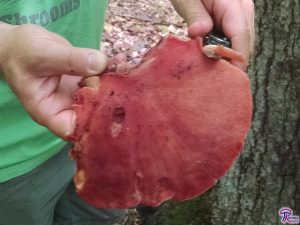#054: Oomycota (Water Molds and Downy Mildews)
The Oomycota (literally “egg fungi”) are remarkable organisms because they mimic fungi on a cellular level. They are heterotrophic (get energy from their surroundings) organisms, exhibit filamentous growth, digest their substrate before absorbing it, and produce sexual and asexual spores. For these reasons, the Oomycota were once classified as fungi. They have since been removed from Kingdom Fungi and placed in Kingdom Protista, Chromista, Straminopila, or whatever name it’s going by today. That means it is most closely related to diatoms and brown algae (like kelp). At first this does not seem like a logical grouping because most of these organisms are autotrophic (make their own food). However, there are a few characteristics of the Oomycota that make them more similar to protists than to fungi. For one, the Oomycota have cell walls composed of cellulose, glycan, and similar molecules. Second, they primarily live as diploids (two copies of each chromosome) and only produce haploid (one copy of each chromosome) cells for a short period of time during gametangial reproduction. Finally, they have motile spores (zoospores) with one tinsel flagellum and one whiplash flagellum. Fungi have cell walls composed of chitin, can grow vegetatively as haploids, and for the most part have non-motile spores. Chytrids and other flagellated fungi produce zoospores with only whiplash flagella.
The Oomycota form four main structures: hyphae, oogonia, antheridia, and zoosporangia. Like the true fungi, the main body of the oomycete is a filamentous web made up of cylindrical cells called hyphae. Septa, the cross-walls that divide the hyphae into cells, are only found at the bases of oogonia, antheridia, and zoosporangia. Because of this, the Oomycota have an undivided cytoplasm containing multiple nuclei and are called coenocytic. Hyphae grow from the tip, just like true fungi. Despite the similarities, these cellular features arose independently and are an excellent example of convergent evolution.
One of the few differentiated structures produced by the Oomycota is the sexual reproductive structure called the oogonium. The oogonium is large and round and contains smaller, but still relatively large, cells called oospheres. The oospheres, or eggs, are products of meiosis and are the structures which gave this group the name “egg fungi.” The other sexual reproductive structure produced by the Oomycota is the antheridium. The antheridium contains a number of haploid nuclei produced by meiosis that are not separated by cell walls. To achieve sexual reproduction, an antheridium perforates the oogonium and releases its nuclei into the oogonium. The antheridium and oogonium may be from the same individual or may be from two different individuals. The nuclei from the antheridium then enter the oospheres and fuse with their nuclei to form diploid spores. Once the spores mature, the wall of the oogonium ruptures and releases the spores, which swim away and then germinate to form new hyphae.
The last differentiated structure produced by the Oomycota is the zoosporangium, which forms asexual spores. Zoosporangia vary widely among the Oomycota and are therefore used for species identification. In general, the zoosporangium is shaped like the tip of a hypha. Once it is cut off from the thallus by the formation of a septum, cell walls develop between the nuclei. Each cell then develops into a zoospore. The zoospores are released once mature and they swim away to form new colonies. There are two types of zoospores: primary and secondary. Primary zoospores germinate to form secondary zoospores. Secondary zoospores germinate to form hyphae. Some species of Oomycota do not form primary zoospores and instead produce secondary zoospores in the zoosporangia.
In general, there are two ecological roles that the Oomycota fill: water molds and plant pathogens. Water molds (you guessed it) thrive in the water and can be found in both freshwater and saltwater. You can find water molds either decomposing various kinds of organic matter or parasitizing animals, algae, or plants. The animals that fall prey to water mold infections include fish, invertebrates, and microscopic organisms. Above water, the Oomycota primarily parasitize plants. These plant pathogens include varieties known as downy mildews, white rusts, blister rusts, root rot, and dampening mold. The plant pathogens have developed some special adaptations for life outside the water. Their sporangia often contain only a few spores and easily fall off, allowing them to be dispersed by the wind. Downy mildews extend their sporangia away from the plant surface, creating a downy appearance and making it easier for the sporangia to be picked up by air currents. The white rusts produce many sporangia at certain spots underneath the plant’s cuticle. Eventually these rupture the plant’s surface and produce lesions that look like those generated by fungal rusts. For many of the terrestrial Oomycota, the sporangia germinate to form hyphae once they land on a suitable substrate. Some may produce sporangia which germinate to form zoospores if they land in water, which makes them very successful in wet weather.
The Oomycota contain some of the most important plant pathogens. The most well-known of these is Phytophthora infestans, which caused the Irish potato famine. The west coast of the United States is currently dealing with Sudden Oak Death, which is caused by Phytophthora ramorum. The Oomycete Plasmopara viticola ravaged the grapes of France in the 1870’s. Peronospora tabacina causes economically significant damage to tobacco crops. There are many other Oomycetes that remain important crop diseases today.
See Further:
http://website.nbm-mnb.ca/mycologywebpages/NaturalHistoryOfFungi/Oomycota.html
http://www.ucmp.berkeley.edu/chromista/oomycota.html
http://www.botany.hawaii.edu/faculty/wong/Bot201/Oomycota/Oomycota.htm







![#011: Characteristics of Kingdom Fungi [Archived]](https://www.fungusfactfriday.com/wp-content/themes/hueman/assets/front/img/thumb-small-empty.png)


1 Response
[…] features listed above are not enough to define Fungi. Some similar organisms like the oomycetes (FFF#054) share all of the basic features. However, they clearly differ at the cellular level. Any […]